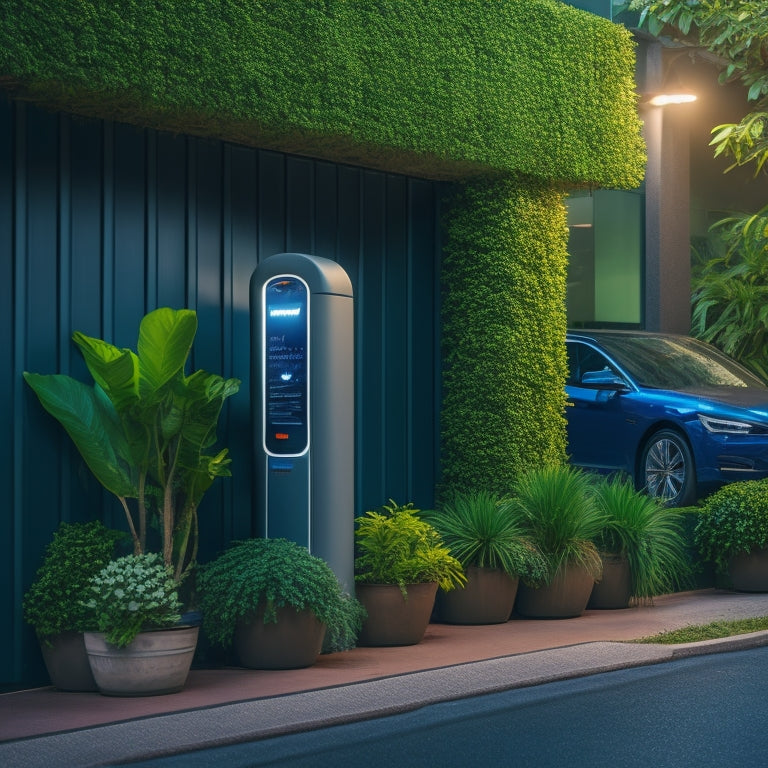
What Vertical Planters Fit Electric Vehicle Charging Stations?
Share
When selecting a vertical planter for your electric vehicle charging station, you'll want to ascertain it complements the station's efficient design while prioritizing safety and functionality. Consider Level 2 chargers' typical 3-4 feet tall and 2-3 feet wide dimensions, and DC Fast Chargers' larger footprint. Choose a planter that provides at least 2-3 feet of clearance space, allows for unobstructed cable management, and supports the station's weight capacity. By considering these factors, you'll find a planter that not only enhances the station's eco-friendly appeal but also streamlines the charging experience - and that's just the starting point for creating a seamless integration of sustainability and technology.
Key Takeaways
- Level 2 chargers require planters with a minimum 2-3 feet clearance space and weight capacity to support the charger and additional features.
- Modular Planters and Green Screens are versatile options that can adapt to different charger sizes and urban landscaping needs.
- Planters with slim profiles and compact footprints optimize limited space around charging stations, ensuring easy vehicle access and maneuverability.
- Durable materials like recycled plastic and fiberglass ensure planter longevity and can withstand outdoor conditions and weight.
- Planter depth considerations, such as built-in drainage systems and adequate root growth, enhance plant health and longevity around EV charging stations.
Electric Vehicle Charging Station Dimensions
As the electric vehicle (EV) revolution gains momentum, the need for efficient and accessible charging infrastructure becomes increasingly pressing.
When designing a charging station layout, you'll want to take into account the dimensions of the charging station itself. Typically, a Level 2 charger is around 3-4 feet tall and 2-3 feet wide. DC Fast Chargers are usually larger, around 6-8 feet tall and 3-4 feet wide.
To maximize energy efficiency and reduce operational costs, think about integrating solar-powered charging solutions that utilize renewable energy and promote energy independence.
When planning your charging station layout, leave enough space for easy vehicle access and maneuverability. Consider installing planters around the perimeter to enhance the aesthetic and create a calming atmosphere.
For planter installation tips, verify the planters are at least 2-3 feet away from the charging station to maintain clearance and avoid any potential electrical hazards.
Measuring Vertical Planter Compatibility
You'll need to guarantee the vertical planters you choose are compatible with your electric vehicle charging station layout. To secure a seamless integration, conduct a compatibility assessment by considering the following factors:
- Clearance space: Measure the distance between the charging station and surrounding obstacles to determine the maximum width of your vertical planter.
Optimize your solar panel array design to maximize energy production, as this will impact the overall performance of your electric vehicle charging station energy-efficient equipment.
- Cable management: Confirm the planter's design allows for easy cable routing and doesn't obstruct the charging station's functionality.
This is vital to reduce installation costs and avoid unnecessary expenses during installation.
- Weight capacity: Select a planter that can support the weight of the charging station, as well as any additional features like solar panels or signage.
Top Brands for EV Charging Stations
You're likely considering which brands to partner with for your EV charging station, and you'll want to confirm their products are compatible with your vertical planters.
As the global electric vehicle market is projected to reach $802.4 billion by 2027 market growth, top brands offer a range of station compatibility options, so you can choose the one that best fits your needs.
From ChargePoint to EVgo, and from Level 2 to DC Fast Charging, you'll find a charger brand that aligns with your sustainable vision.
Station Compatibility Options
Several top brands for EV charging stations have made compatibility with vertical planters a priority, recognizing the growing demand for sustainable and eco-friendly urban environments.
As you investigate station compatibility options, you'll find that leading brands cater to your needs. Many of these brands prioritize climate leadership and energy independence, offering renewable energy solutions that reduce greenhouse gas emissions and carbon footprint.
They also consider the importance of fleet safety, designing their stations with fewer moving parts and lower fire risks.
- They provide detailed installation requirements, ensuring a seamless integration with your vertical planters.
- They offer flexible electrical specifications, allowing you to choose the perfect charger for your setup.
- They design their stations with space efficiency in mind, making it easy to accommodate planters and other urban features.
Charger Brand Variety
Your search for top EV charger brands that cater to your vertical planter needs ends here. You'll find a range of reliable brands that prioritize eco-friendliness and efficiency.
Look for charger features like fast charging speeds, Wi-Fi connectivity, and smart charging capabilities. Additionally, consider implementing time-of-use rate strategies to optimize your charging schedule and reduce energy costs.
Top brands like ChargePoint, EVgo, and Blink offer high-quality chargers that seamlessly integrate with your vertical planters. Brand reliability is essential, so consider manufacturers that provide extensive warranties and dedicated customer support.
Some brands, like Tesla, offer exclusive charging networks for their vehicles. Research each brand's features, pricing, and customer reviews to find the perfect fit for your electric vehicle and vertical planter setup.
Popular Vertical Planter Options
As cities move towards a sustainable future, integrating EV charging stations with lush greenery is becoming increasingly popular, and vertical planters are playing an essential role in this eco-friendly revolution.
You're likely wondering which planters are best suited for this purpose.
Some popular vertical planter options for EV charging stations include:
-
Living Walls: These planters provide a sleek, modern look while maximizing space for sustainable gardening.
-
Green Screens: Perfect for urban landscaping, these planters offer a versatile design that can be mounted on walls or fences.
-
Modular Planters: These planters offer flexibility and can be easily rearranged to fit your unique space and design needs.
Space-Saving Planter Design Features
When it comes to vertical planters for EV charging stations, every inch counts. You need to maximize space while maintaining a visually appealing display of greenery.
To achieve this, look for planters with space-saving design features like slim profiles, compact footprints, and wall-mounted or trellis-style installations. These designs allow for efficient use of space, making them perfect for urban landscaping and sustainable gardening.
Additionally, consider planters with built-in irrigation systems, which reduce water waste and make maintenance a breeze.
Charging Station Aesthetics Matters
The sleek, modern design of EV charging stations demands a visually appealing surrounding environment. You want your charging station to blend seamlessly into its urban surroundings, which is where thoughtful charging station landscaping comes in.
By incorporating vertical planters, you can create a harmonious balance between technology and nature.
Here are some key considerations for creating an aesthetically pleasing charging station:
-
Greenery around the base: Planting low-maintenance, drought-resistant plants around the base of the charging station can add a pop of color and soften the industrial look.
-
Urban gardening features: Incorporating urban gardening elements, such as living walls or green roofs, can create a unique and Instagram-worthy spot.
-
Lighting design: Strategically placed lighting can highlight the charging station's sleek design while also creating a safe and welcoming atmosphere.
Planter Size and Material Considerations
When selecting a planter for your EV charging station, you'll need to evaluate the depth options to guarantee the plants' roots have enough room to grow.
You'll also want to choose durable materials that can withstand outdoor conditions and support the weight of the soil and plants.
Planter Depth Options
Your vertical planter's depth is essential, as it directly impacts the health and longevity of the plants, as well as the overall aesthetic of the EV charging station. A planter that's too shallow can lead to waterlogged soil, while one that's too deep can be difficult to maintain. You'll want to strike a balance between the two.
Here are some key considerations for planter depth:
-
Planter drainage: Make certain your planter has a built-in drainage system or a material that allows for airflow, preventing waterlogged soil and root rot.
-
Planter accessibility: Choose a planter with a depth that allows for easy planting, pruning, and maintenance, without straining your back or requiring ladders.
-
Root growth: Consider the mature size of your plants' roots and choose a planter that provides ample room for growth, making certain healthy and thriving plants.
Durable Material Choices
Selecting a durable, eco-friendly material for your vertical planter is vital to guaranteeing the longevity of both the planter and the plants it supports. You want a material that can withstand the elements and maintain its integrity over time.
Look for materials with high material durability, such as recycled plastic or fiberglass, which can resist weathering and corrosion. Weather resistance is also essential, as it guarantees your planter can handle exposure to rain, sunlight, and extreme temperatures.
Consider materials with built-in UV protection, water resistance, and rust-proof coatings to make sure your planter remains functional and visually appealing.
Frequently Asked Questions
Can Vertical Planters Be Installed on Uneven or Sloping Surfaces?
You can successfully install vertical planters on uneven or sloping surfaces by ensuring vertical planter stability with specialized bases or adjustable feet, which provide sloping terrain solutions that adapt to various angles and surfaces, giving you freedom to greenify any space.
Do Electric Vehicle Charging Stations Require Specific Planter Types?
You'll be surprised to know that 80% of EV owners prioritize eco-friendly designs! When choosing planters for electric vehicle charging stations, you'll want to select materials that complement the station's aesthetic, such as sleek metal or recycled plastic planters that blend seamlessly.
Will Adding Planters Increase Electric Vehicle Charging Station Costs?
When you add planters to an electric vehicle charging station, you'll need to contemplate cost considerations, such as the type of planter materials used, which can increase overall costs, but opting for eco-friendly, sustainable options can help minimize the financial impact.
Can Planters Be Customized to Fit Specific Charging Station Designs?
You can commission custom planter designs that seamlessly integrate with your charging station's unique aesthetic, ensuring a harmonious blend of sustainability and style that enhances the overall user experience while promoting eco-friendliness.
Are There Any Local Regulations for Planter Height Near Charging Stations?
Scanning your surroundings, you'll find that savvy site selectors scrutinize local laws, ensuring regulatory compliance for planter dimensions near charging stations, as varying heights and widths affect accessibility and functionality in eco-friendly infrastructure.
Related Posts
-

What Do Power Strips Do for Standby Energy?
You're likely aware that your devices, such as TVs and computers, continue to draw power even when turned off, a phen...
-

Why Merge Earth's Heat With Sun's Energy?
You're about to utilize the full potential of renewable energy by combining the Earth's natural heat with the Sun's a...
-

7 Smart Air Purification Hacks for Energy-Savvy Homes
You can notably improve your indoor air quality while minimizing energy consumption by implementing strategic air pur...


